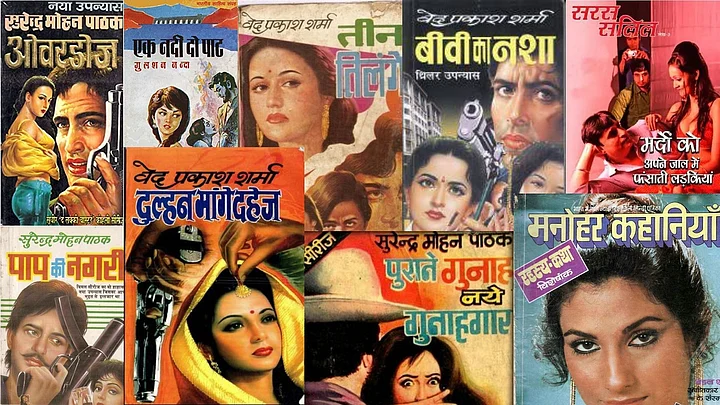A question troubling everyone after watching Taapsee Pannu, Vikrant Massey-starrer Haseen Dillruba is — who is Dinesh Pandit? The answer to this lies back in time when Hindi pulp fiction was at its peak.
Vardi Wala Gunda, Pyaar Ka Mohra, Phas Hi Gayi Kaatil Biwi, Solva Sawan, Grahini Ka Pratishodh — these pulp fiction thrillers quietly made their way from the bus stands and railways stations to underneath the pillows of a generation of readers. If not these, the timeless Manohar Kahaniyaan and Saras Salil were sure to find a place. For a society sans the internet, these pulpy pages remained a dedicated asset for its rituals of amusement and 'pleasure', without the VPN.
In a conversation with The Quint, the film's writer Kanika Dhillon revealed that Dinesh Pandit is a homage to all the pulp fiction authors she grew up reading. These writers had huge readerships, and their stories a loyal and dedicated fanbase. So much so that these books were enough to ignite wrestles and contests between friends as to who will get to read the book first. Indeed, the true test of friendship. It’s almost impossible for the Gen-Z to believe that before the ‘Netflix and chill’, there was the hushed ‘under the pillow-talk’.
Ved Prakash Sharma
The belt of heartland Hindi pulp fiction is incomplete without the glorious Ved Prakash Sharma. Legend has it that, when several hailed editors and writers were turning to the management and literary intelligence to reach small pockets of readers, this small-town writer from Meerut ruled hearts with his Hindi pulp novels.
The first edition of Vardi Wala Gunda alone sold 15 Lakh copies. The later editions were so popular that they lost count. He never used explicit sexual content to sell his books, and was admired by young men and women alike. Bollywood has drawn inspiration from his novels multiple times. In 1985, Shashilal Nair adapted his novel Bahu Maange Insaaf for screen —Bahu Ki Aawaz. A decade later, in 1995, Sabse Bada Khiladi, and then in 1999, International Khiladi were made, both of which were adaptations of his novel Lallu.
Surendra Mohan Pathak
Having written over 300 novels, Surendra Mohan Pathak is often regarded as the ‘Grand Master’ of Hindi pulp fiction. His books were loved so much that there’d be waiting lists outside the bookstores.
His writing career commenced in 1960 with his full-time job in Delhi in the Indian telecom industry, when he translated Ian Fleming’s James Bond to Hindi. His first short story, 57 Saal Purana Aadmi, was published in one of the most popular magazines at the time — Manohar Kahaniyaan. His first novel, Puraane Gunah, Naye Gunehgaar, was published in the widely-read Neelam Jasoos in 1963.
Following his initial success, he delivered a string of crime novels, and his audience amplified. He wrote over 100 novels based on the beloved character of Sunil Chakravarty, an investigative journalist. Not only that, another one of his characters — private detective Sudhir Kohli — was a hit among the readers. His book, Colaba Conspiracy, was voted the most popular book on Amazon in 2014.
Gulshan Nanda
Gulshan Nanda widened the genre of Hindi pulp fiction by integrating crime thrillers with romance, and stories set in domestic environments. At a time when readers were gripped with the work of famous novelists like Ibne Safi, he constructed tales around tropes such as the rich and poor, twin brothers, the big city guy and the girl from the village, daughter of a wealthy household in love with a poor guy. These stories attracted massive readership to him.
His novels Neelkanth and Gaylord swept the readers and he became the most popular name among the pulp writers.
Parents, under the guise that his books are not meant for children, would conveniently have the same books under their pillows. There was nobody who was a stranger to Nanda’s books.
An Era Beyond the Novels
Apart from these bulky novels, there was a multitude of monthly subscription-based magazines that would easily surpass the sales of the mainstream political ones.
In small towns, this was the time of subscriptions not for Amazon Prime or Netflix, but Saras Salil and Manohar Kahaniyaan. However, the era of hiding these magazines under the pillow has long gone.
(At The Quint, we question everything. Play an active role in shaping our journalism by becoming a member today.)
